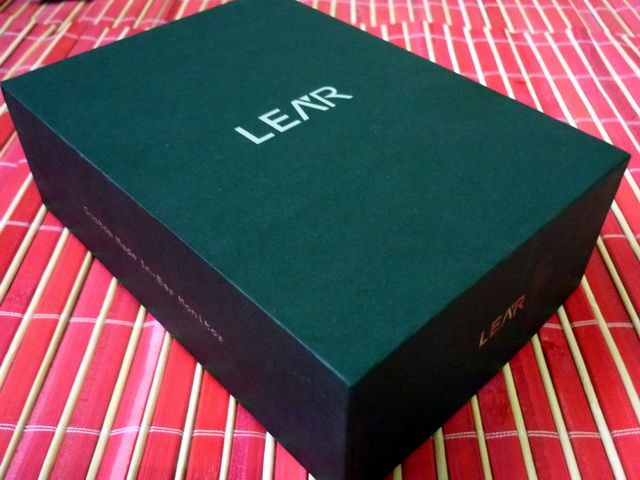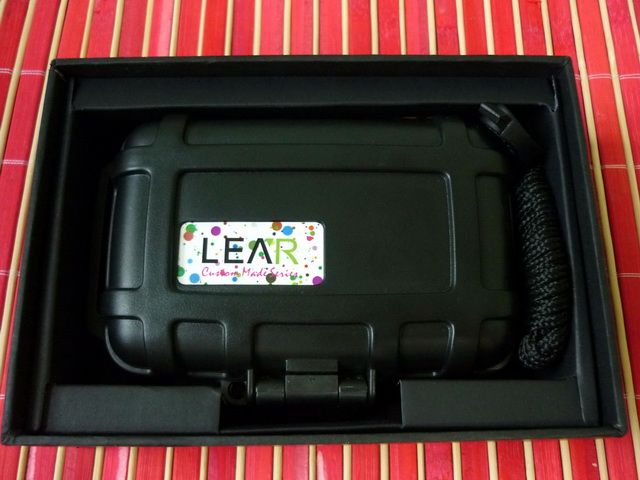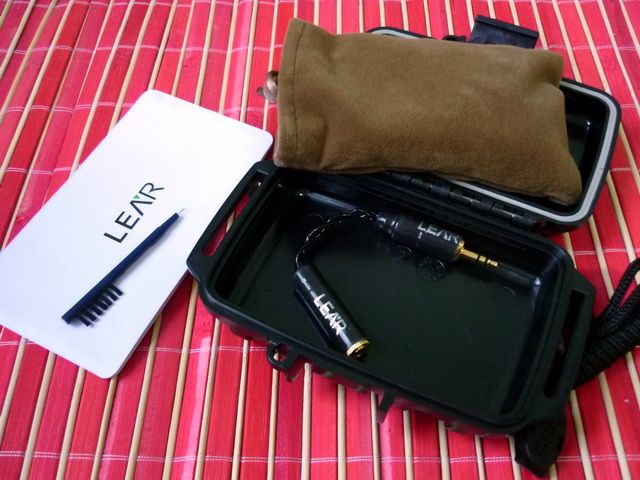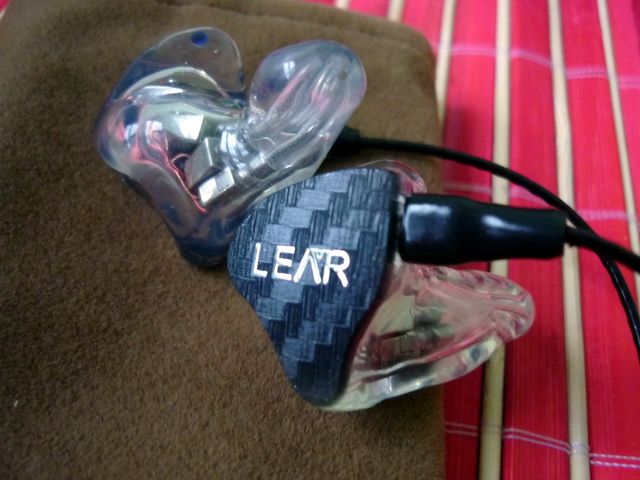p/s: LEAR launched their Japanese site recently as well.

Spec
Frequency Response: 20Hz -22kHz
Impedance: 28ohm @ 1kHz
Sensitivity: 122dB @1mW
THD Ratio: Below 0.6% (20Hz - 10kHz)
Driver: 5 Balanced Armature (single low, dual mid, dual high)
Crossover: Passive 3 ways
Price: US$910*
(*estimated from HKD)

Packaging, Accessories, and Build Quality
Everything comes in a heavy paper box – or more precisely, in an Otter Box inside a heavy paper box. The custom IEM (CIEM) itself is in a soft pouch inside the Otter Box, plus a simple manual as well as a cleaning tool. If you ordered the optional US$90 Monitor Sound Tuned Adapter (MSTA) along with the CIEM, it should be inside as well.
The Otter Box itself is quite good, most definitely very tough. Personally however, I like Pelican Case as they usually have soft rubber lining. The case is quite big and good for travelling, but you might want to consider getting the smaller sized Westone Monitor Vault as well, just for day to day use.
If you are a first time CIEM user, do remember to use the cleaning tool regularly, especially to keep the sound bores as clean as possible. Also, wipe the shell clean after each use. Alcohol wipe is fine as well.
The MSTA is a short piece of cable custom made with resistors and capacitors inside to tune the sound of LCM-5, and we will touch on that in the SQ section. For now, you need to know that it will increase the impedance by several folds and decrease the IEM sensitivity, so it is intended to be used with an amp or something with a fairly powerful output.
The build quality of the earpiece itself is close to impeccable. You can see from the pictures that it is hard acrylic shell and has no bubble at all. It has three bores – for treble, mid and bass separately. The IEM uses dual treble, dual mid and one bass balanced armature in a 3 ways setup. The faceplate in the picture is a US$52 add-on called ‘true texture’, which resembles carbon fiber but it is actually a kind of 3D printing. The chromed LEAR logo is however free of charge if you want it. On first glance, the stock cable looks a bit underwhelmed. It is actually good quality silver plated OFC, though it might not look like much. LEAR has planned to replace it with something more eye catching, but it is not ready yet.

The Monitor Sound Tuned Adapter is in the Otter Box.
Fit and Isolation
The right side of my LCM-5 was a bit loose when first received. After confirming it is indeed a little loose, I sent it back for a refit, basically adding just a bit more acrylic. The whole turn around took less than a week. Though it is very fast, it does depend on the lab’s workload as well so take my words on it. After the refit, everything fits perfectly. They are on the tighter side, but not uncomfortable even after long hours. Isolation is very high, probably around -30dB or so.
SQ
The IEM has been given over 50 hours of burn-in before the review.
LCM-5 has two faces: one is its normal face, the other one is the monitor-tuned face with the MSTA (Monitor Sound Tuned Adapter).
On its normal face, LCM-5 is warm, rich, well extended to both ends, and somewhere between stage-monitor-like and being musical with a smooth top. Bass is a bit more than neutral, but far from bass monster quantitatively. It reaches down to sub-bass, well bodied and textured with a good amount of impact, and has a really good decay as well, almost like a good dynamic transducer. Mid is the center of the presentation as it is sweet, detailed, rich but not overly forward. It isn’t really a mid-centric sound as it is still in-line with bass as far as forwardness is concerned, but it is the liquidity in its presentation that draws the listener’s attention naturally. This makes vocal being rendered beautifully on LCM-5, nothing less even compared to mid-centric IEM. Treble is well extended as well, crisp and sparkly but it is half-a-step behind mid and bass. This gives it a sense of smoothness but not being veil in anyway. Micro detail is still all there, but they are not the focus. Soundstage is well above average but not the widest ever – more enveloping than it is open-ended, but with well rendered layers. Image and position suffer slightly due to the richness, but it is part of the appeal of having a warm sound and I don’t consider it a downside that much.
With MSTA, LCM-5 takes on a different a different personality. Now it is more neutral and reference flat in frequency response, almost like Etymotic ER4S with a richer body. The transformation with and without MSTA is somewhat similar to ER4S and ER4P, except it is more pronounced and doesn’t drop in SQ. Bass still extends down deeply, but along with the mid they both take a back seat to upper vocal and treble. The focus has shifted from the more stage-monitor-like to a more reference-analytical-monitor-like presentation. However, there is still a small amount of fullness left in the mid and bass so it isn’t particularly sterile or cold like an Etymotic. But the similarity in brightness and hyper-detailed presentation are an unmistakably sign that MSTA is meant to tune LCM-5 to be as accurate as possible. As explained by LEAR, LCM-5 is tuned for music listening first and foremost, and so they go for a warmer and smoother sound in the original configuration. The addition of MSTA is for those who wish to use LCM-5 for studio monitoring* and mixing, where accuracy is prioritized over musicality and being more fatigue-free (*not to be confused with stage monitoring, where a warmer and fatigue-free tends to be much more preferred). Besides being more accurate on the frequency response curve, one area of noticeable improvement is the soundstage. As previously stated, the original warmer, richer sound tends to cloud the image just a tiny bit by limiting how far the soundstage can expend. With the MSTA, the soundstage regains its open-ended definition. Of course, this is also part of the reason why MSTA-paired LCM-5 sounds more accurate and precise.
One thing to take note is that MSTA will push the IEM impedance much higher (around 180ohm in total as compared to the 28ohm without it) as well as lowering sensitivity, so you do need a good amp to power it to fullness, or at least a source that has a lot of voltage swing. Also, MSTA is not just a resistors adapter like that of Etymotic P-to-S adapter, so using a resistors adapter likely won’t replicate the same sound. Consider that you already spent $900 on LCM-5, I think the extra $90 shouldn’t be skipped.
I have heard my fair share of CIEM demo units (most of JH, UE, and FitEars, plus a few others) and I can honestly say that LCM-5 belongs to the top-tiers without a doubt. Of course, it really isn’t fair to compare a full-blown CIEM to demo units (which might not sound as their best) but at a certain point, once you listened to enough of them, that all the good and bad are more about tuning difference rather than actual SQ difference - ‘Pick your poison’, so to speak. With LCM-5, the two flavors have been pre-formulated for the listener, and that comes as a big plus in my opinion.

Sidetracked
Here are some thought I have. Not necessary the most correct of things, but they are true to my own experience.
I was asked quite a few times to recommend IEM with the hardest hitting bass, sweetest mid, most sparkling treble and the widest sounding soundstage – it would seem to be the perfect IEM, but it could just as well be terrible sounding. For example, take an IEM and bring the treble up a little to make it more treble detail, then bass and mid will be feel relatively more neutral. Take the same IEM and now bump the bass as well, you will get a V-shaped sound with bright treble and heavy bass while the mid is relatively recessed. Take the same IEM again and push the mid forward – well, you might think you finally have everything right but now it just sound like the same IEM before you changes the treble, except more sensitive and can get louder faster. You will have neither a more detailed treble, a harder hitting bass nor a sweeter mid. As you can see, the sound signature of an IEM isn’t all about the ‘sum’ of all its parts, but the ‘ratio’ of them as well. A bad sounding IEM simply lacks all the ‘good parts’, so the sum is still bad and thus the ratio is not important. An entry level will have a mix of good and bad parts and generally the ratio is about even. A mid-tier IEM will have more good than bad and generally the ratio is favoring the good but it isn’t quite perfect yet. That’s where strength is overshadowing the weakness, allowing the listener to ignore its existence. A top-tier is that which has very little bad and is able to get the ratio to just about right. Some of them can still have very strong flavor, but even so the weakest part of the whole presentation will still maintain good quality (and thus a good ratio to the strength of the presentation). That is really what defines a top-tier. It is just as important to have all the basic of a good sound as it is to have the right amount of each element. Of course, no IEM can really be perfect for everyone, not even a top-tier, as every listener still has his/her own preference and interpretation. But the one thing I am certain of, is that I have not heard an IEM, custom or universal, that has everything flawless to every taste and every genre of music. So essentially it is down to what kind of compromise you are willing to take so you can find an IEM that best fitting to your need.

Verdict
LCM-5 is one of the best listening experiences I have, among in-ears as well as full sized. For an IEM that costs nearly a thousand bones, I guess one shouldn’t expect less. Talking about value has become somewhat of a moot point as IEM of this calibre are more or less a money-is-no-object pursuit for sound quality. However, If I have to put as estimation on it, I'll say it is well worth the asking price. The important bit is, LEAR has demonstrated that they can compete with the top dogs and I think it would be silly not to put LCM-5 into the list of consideration if you are looking for a flagship custom. The original sound will appeal to those who are looking for something warm, versatile and technically strong. The Monitor Sound Tune Adapter will be the icing on the cake for those who prefer the occasional high definition. You can hardly go wrong between them.
A thank to LEAR for the sample.
Check out The List for quick rating.





